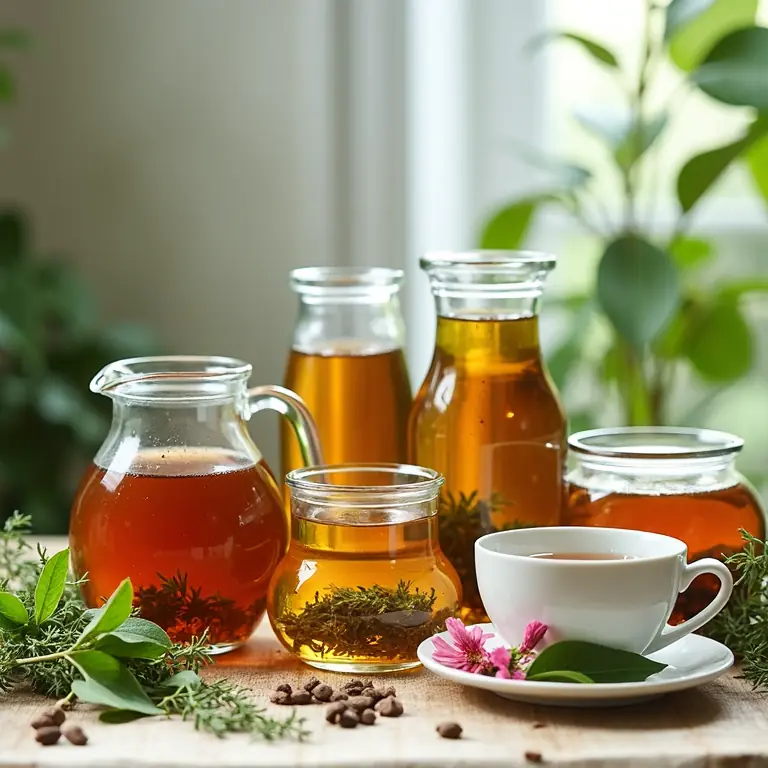Brew Botanical Infusions: A Friendly Guide to Herbal Remedy Teas
For centuries, humans have turned to the natural world for healing. Long before modern pharmaceuticals, our ancestors relied on the power of plants – not just for food, but for medicine. One of the most accessible and delightful ways to harness this botanical power is through herbal infusions, commonly known as herbal teas. This guide will walk you through the fascinating world of herbal remedy teas, covering everything from basic brewing techniques to the benefits of specific herbs and safety considerations. We’ll explore how to create your own soothing and supportive drinks, empowering you to take a proactive role in your well-being.
What *Are* Herbal Teas? A Clarification
It’s important to distinguish between “true” teas (black, green, white, oolong, pu-erh) and herbal teas. True teas come from the Camellia sinensis plant. Herbal teas, on the other hand, are technically tisanes – infusions made from herbs, spices, flowers, roots, seeds, or fruits. Because they don’t contain Camellia sinensis, they are naturally caffeine-free (though some blends might include small amounts of tea leaves). This makes them a wonderful option for those seeking a calming beverage or looking to avoid caffeine.
The Benefits of Herbal Infusions
The benefits of herbal teas are vast and varied, depending on the herbs used. Here’s a glimpse into what these botanical brews can offer:
- Stress Reduction & Relaxation: Herbs like chamomile, lavender, and lemon balm are renowned for their calming properties.
- Improved Digestion: Peppermint, ginger, and fennel can soothe digestive upset, reduce bloating, and aid in nutrient absorption.
- Immune Support: Echinacea, elderberry, and ginger are known for their immune-boosting capabilities.
- Enhanced Sleep: Chamomile, valerian root, and passionflower can promote restful sleep.
- Anti-inflammatory Properties: Turmeric, ginger, and rosemary possess powerful anti-inflammatory compounds.
- Antioxidant Power: Many herbs are rich in antioxidants, which protect cells from damage caused by free radicals.
Brewing Basics: The Art of the Infusion
Brewing herbal tea is simple, but a few key techniques can significantly enhance the flavor and potency. Here’s a breakdown:
Water Quality Matters
Start with good quality water. Filtered water is best, as chlorine and other impurities can affect the taste. Avoid distilled water, as it lacks the minerals necessary to properly extract the beneficial compounds from the herbs.
Temperature Control
Water temperature is crucial. Different herbs require different temperatures to release their flavors and medicinal properties:
- Delicate Flowers & Leaves (Chamomile, Lavender, Mint): 170-185°F (77-85°C) – Just below boiling.
- Sturdier Leaves (Lemon Balm, Raspberry Leaf): 190-200°F (88-93°C)
- Roots, Barks, & Seeds (Ginger, Cinnamon, Fennel): 200-212°F (93-100°C) – Full boiling.
If you don’t have a temperature-controlled kettle, let boiling water cool slightly before pouring it over delicate herbs.
Infusion Time: Patience is Key
Infusion time also varies depending on the herb. Generally:
- Flowers & Leaves: 5-15 minutes
- Roots & Barks: 15-30 minutes (or longer for stronger infusions)
- Seeds: 10-20 minutes
Covering the cup or pot while infusing helps to retain volatile essential oils, maximizing the flavor and therapeutic benefits. Taste the tea periodically to determine when it has reached your desired strength.
Dosage: Finding Your Sweet Spot
Generally, 1-2 teaspoons of dried herb per 8 ounces of water is a good starting point. You can adjust this based on your preference and the herb’s potency. For fresh herbs, use 2-3 times the amount of dried herb.
Popular Herbs & Their Uses
Let’s delve into some popular and effective herbal remedy teas:
Chamomile (Matricaria chamomilla)
Benefits: Calming, relaxing, promotes sleep, soothes digestive upset, reduces inflammation.
Brewing: 1-2 tsp dried flowers per 8oz water, 170-185°F, 5-10 minutes.
Notes: A classic bedtime tea. Avoid if allergic to ragweed.
Peppermint (Mentha × piperita)
Benefits: Aids digestion, relieves bloating, soothes headaches, freshens breath.
Brewing: 1-2 tsp dried leaves per 8oz water, 190-200°F, 5-10 minutes.
Notes: Can exacerbate acid reflux in some individuals.
Ginger (Zingiber officinale)
Benefits: Anti-inflammatory, boosts immunity, aids digestion, relieves nausea, warms the body.
Brewing: 1-2 tsp grated fresh ginger or 1/2 tsp dried ginger per 8oz water, 200-212°F, 10-20 minutes.
Notes: Can interact with blood thinners.
Echinacea (Echinacea purpurea)
Benefits: Boosts immunity, fights off colds and flu, anti-inflammatory.
Brewing: 1-2 tsp dried root or aerial parts per 8oz water, 200-212°F, 15-30 minutes.
Notes: Best used at the first sign of illness. Not recommended for long-term daily use.
Lemon Balm (Melissa officinalis)
Benefits: Calming, reduces stress, improves sleep, antiviral properties.
Brewing: 1-2 tsp dried leaves per 8oz water, 170-185°F, 5-10 minutes.
Notes: A lovely addition to chamomile blends.
Hibiscus (Hibiscus sabdariffa)
Benefits: Rich in antioxidants, supports heart health, may lower blood pressure.
Brewing: 1-2 tsp dried flowers per 8oz water, 200-212°F, 5-10 minutes.
Notes: Has a tart, cranberry-like flavor. May interact with certain medications.
Rosemary (Salvia rosmarinus)
Benefits: Improves memory and concentration, boosts circulation, anti-inflammatory.
Brewing: 1 tsp dried leaves per 8oz water, 200-212°F, 10-15 minutes.
Notes: Use sparingly, as it can be quite potent. Avoid if pregnant or have high blood pressure.
Creating Your Own Blends: A World of Possibilities
Once you’re comfortable brewing individual herbs, you can start experimenting with blends! Here are a few ideas:
- Relaxation Blend: Chamomile, Lavender, Lemon Balm
- Digestive Support Blend: Peppermint, Ginger, Fennel
- Immunity Boost Blend: Echinacea, Elderberry, Ginger, Lemon
- Energy & Focus Blend: Rosemary, Peppermint, Ginger
Don’t be afraid to get creative and find combinations that suit your taste and needs. Start with small batches and adjust the proportions until you achieve your desired flavor profile.
Sourcing Herbs: Quality Matters
Where you source your herbs is crucial. Look for:
- Organic Certification: Ensures the herbs are grown without harmful pesticides or herbicides.
- Reputable Suppliers: Choose companies that specialize in herbs and have a good reputation for quality control.
- Proper Storage: Store herbs in airtight containers in a cool, dark, and dry place to preserve their potency.
Growing your own herbs is also a fantastic option! It ensures freshness and allows you to control the growing conditions. If you’re interested in growing your own, you might find inspiration in learning how to build your own compost to nourish your plants.
Safety Considerations & Precautions
While herbal teas are generally safe, it’s important to be aware of potential interactions and contraindications:
- Pregnancy & Breastfeeding: Some herbs are not safe during pregnancy or breastfeeding. Consult with a healthcare professional before consuming any herbal teas.
- Medication Interactions: Certain herbs can interact with medications. Always check with your doctor or pharmacist before using herbal teas if you are taking any medications.
- Allergies: Be mindful of potential allergies. If you are allergic to ragweed, for example, avoid chamomile.
- Dosage: Follow recommended dosages. More is not always better.
- Long-Term Use: Some herbs are not intended for long-term daily use.
Disclaimer: This information is for educational purposes only and is not intended as a substitute for professional medical advice. Always consult with a qualified healthcare provider before using herbal teas for medicinal purposes.
Expanding Your Knowledge
The world of herbalism is vast and fascinating. If you’re interested in learning more, consider exploring resources such as:
- Books on Herbalism: Look for books written by reputable herbalists.
- Online Courses: Many online courses offer in-depth training in herbal medicine.
- Local Herbalists: Connect with local herbalists for personalized guidance.
Understanding your own personality and habits can also help you tailor herbal remedies to your unique needs. You might even find connections between your inner self and the natural world by exploring practices like graphology, or by taking on a creative and mindful project like building a bookshelf.
Here’s a helpful video summarizing some of the best herbal teas:
Embrace the Ritual
Brewing and enjoying herbal teas is more than just a way to address health concerns. It’s a ritual—a moment to pause, connect with nature, and nurture yourself. Take the time to savor the aroma, the flavor, and the warmth of each cup. Embrace the simple pleasure of a well-brewed infusion, and allow its gentle power to support your well-being.


Discussion about this post